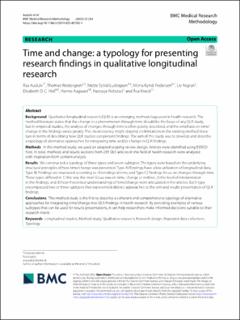| dc.contributor.author | Audulv, Åsa | |
| dc.contributor.author | Westergren, Per Christer Thomas | |
| dc.contributor.author | Ludvigsen, Mette Spliid | |
| dc.contributor.author | Pedersen, Mona Kyndi | |
| dc.contributor.author | Fegran, Liv | |
| dc.contributor.author | Hall, Elisabeth O. C. | |
| dc.contributor.author | Aagaard, Hanne | |
| dc.contributor.author | Robstad, Anja Nastasja | |
| dc.contributor.author | Kneck, Åsa | |
| dc.date.accessioned | 2023-12-19T13:55:50Z | |
| dc.date.available | 2023-12-19T13:55:50Z | |
| dc.date.created | 2023-11-16T12:56:12Z | |
| dc.date.issued | 2023 | |
| dc.identifier.citation | Audulv, Å., Westergren, T., Ludvigsen, M. S., Pedersen, M. K., Fegran, L., Hall, E. O., ... & Kneck, Å. (2023). Time and change: a typology for presenting research findings in qualitative longitudinal research. BMC Medical Research Methodology, 23(1). | en_US |
| dc.identifier.issn | 1471-2288 | |
| dc.identifier.uri | https://hdl.handle.net/11250/3108235 | |
| dc.description.abstract | Background: Qualitative longitudinal research (QLR) is an emerging methodology used in health research. The method literature states that the change in a phenomenon through time should be the focus of any QLR study, but in empirical studies, the analysis of changes through time is often poorly described, and the emphasis on time/change in the findings varies greatly. This inconsistency might depend on limitations in the existing method literature in terms of describing how QLR studies can present findings. The aim of this study was to develop and describe a typology of alternative approaches for integrating time and/or change in QLR findings.
Methods: In this method study, we used an adapted scoping review design. Articles were identified using EBSCOhost. In total, methods and results sections from 299 QLR articles in the field of health research were analyzed with inspiration from content analysis.
Results: We constructed a typology of three types and seven subtypes. The types were based on the underlying structural principles of how time/change was presented: Type A) Findings have a low utilization of longitudinal data, Type B) Findings are structured according to chronological time, and Type C) Findings focus on changes through time. These types differed in 1) the way the main focus was on time, change or neither; 2) the level of interpretation in the findings; and 3) how theoretical understandings of time/change were articulated in the articles. Each type encompassed two or three subtypes that represented distinct approaches to the aim and results presentation of QLR findings.
Conclusions: This method study is the first to describe a coherent and comprehensive typology of alternative approaches for integrating time/change into QLR findings in health research. By providing examples of various subtypes that can be used for results presentations, it can help researchers make informed decisions suitable to their research intent. | en_US |
| dc.language.iso | eng | en_US |
| dc.rights | Navngivelse 4.0 Internasjonal | * |
| dc.rights.uri | http://creativecommons.org/licenses/by/4.0/deed.no | * |
| dc.subject | Kvalitativ forskning | en_US |
| dc.title | Time and change: A typology for presenting research findings in qualitative longitudinal research | en_US |
| dc.title.alternative | Time and change: A typology for presenting research findings in qualitative longitudinal research | en_US |
| dc.type | Peer reviewed | en_US |
| dc.type | Journal article | en_US |
| dc.description.version | publishedVersion | en_US |
| dc.rights.holder | © The Author(s) 2023. | en_US |
| dc.source.volume | 23 | en_US |
| dc.source.journal | BMC Medical Research Methodology | en_US |
| dc.identifier.doi | 10.1186/s12874-023-02105-1 | |
| dc.identifier.cristin | 2197584 | |
| dc.source.articlenumber | 284 | en_US |
| cristin.ispublished | true | |
| cristin.fulltext | original | |
| cristin.qualitycode | 1 | |

